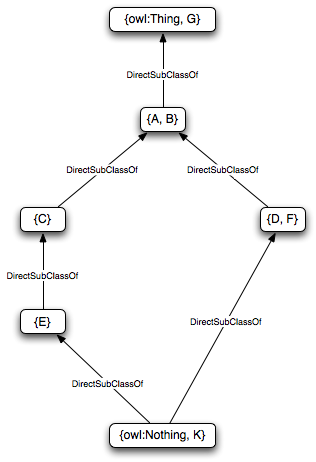
|
|||||||||
| PREV CLASS NEXT CLASS | FRAMES NO FRAMES | ||||||||
| SUMMARY: NESTED | FIELD | CONSTR | METHOD | DETAIL: FIELD | CONSTR | METHOD | ||||||||
public interface Node<E extends OWLObject>
Author: Matthew Horridge
The University of Manchester
Information Management Group
Date: 03-Jul-2009
Nodes. Each node contains entities that are equivalent
to each other. A hierarchy contains a top node, which is the ancestor of all nodes in the hierarchy, and
a bottom node which is the descendant of all nodes in the hierarchy.
In a class hierarchy, the nodes contain OWLClass objects. The top node contains owl:Thing (and
any other named classes that are equivalent to owl:Thing).
The bottom node contains owl:Nothing
(and any other named classes that are equivalent to owl:Nothing - these classes are unsatisfiable
classes).
In an object property hierarchy, the nodes contain OWLObjectProperty objects. The top node contains
owl:topObjectProperty (and any other named object properties that are equivalent to owl:topObjectProperty).
The bottom node contains owl:bottomObjectProperty
(and any other named object properties that are equivalent to owl:bottomObjectProperty).
In a data property hierarchy, the nodes contain OWLDataProperty objects. The top node contains
owl:topDataProperty (and any other data properties that are equivalent to owl:topDataProperty).
The bottom node contains owl:bottomDataProperty
(and any other data properties that are equivalent to owl:bottomDataProperty).
Node. In
this case the top node contains owl:Thing and the bottom node contains owl:Nothing
because the nodes in the hierarchy are OWLClass nodes. In this case, class G
is equivalent to owl:Thing so it appears as an entity in the top node. Similarly, class K
is unsatisfiable, so it is equivalent to owl:Nothing and therefore appears in the bottom node containing
owl:Nothing.

| Method Summary | |
|---|---|
boolean |
contains(E entity)
Determines if this node contains the specified entity. |
java.util.Set<E> |
getEntities()
Gets the entities contained in this node. |
java.util.Set<E> |
getEntitiesMinus(E e)
Gets the entities contained in this node minus the specified entitie e. |
java.util.Set<E> |
getEntitiesMinusBottom()
Gets the entities contained in this node minus the bottom entity. |
java.util.Set<E> |
getEntitiesMinusTop()
Gets the entities contained in this node minus the top entity. |
E |
getRepresentativeElement()
Gets one of the entities contained in this entity set. |
int |
getSize()
Gets the number of entities contained in this Node |
boolean |
isBottomNode()
Determines if this node represents the bottom node (in a hierarchy). |
boolean |
isSingleton()
Determines if this Node contains just one entity. |
boolean |
isTopNode()
Determines if this node represents the top node (in a hierarchy). |
| Methods inherited from interface java.lang.Iterable |
|---|
iterator |
| Method Detail |
|---|
boolean isTopNode()
owl:Thing. For an object property node, the top node
is the node that contains owl:topObjectProperty. For a data property node, the top node is the
node that contains owl:topDataProperty
true if this node is an OWLClass node and it contains owl:Thing.
true if this node is an OWLObjectProperty node and it contains owl:topObjectProperty.
true if this node is an OWLDataProperty node and it contains owl:topDataProperty.
false if none of the above.boolean isBottomNode()
owl:Nothing. For an object property node, the bottom node
is the node that contains owl:bottomObjectProperty. For a data property node, the bottom node is the
node that contains owl:bottomDataProperty
true if this node is an OWLClass node and it contains owl:Nothing.
true if this node is an OWLObjectProperty node and it contains owl:bottomObjectProperty.
true if this node is an OWLDataProperty node and it contains owl:bottomDataProperty.
false if none of the above.java.util.Set<E> getEntities()
Node.int getSize()
Node
boolean contains(E entity)
entity - The entity to check for
true if this node contains entity, or false if this node
does not contain entityjava.util.Set<E> getEntitiesMinus(E e)
e. This essentially
returns the entities that are returned by getEntities() minus the specified entity e
e - The entity that, is contained within this node, but should not be included in the return set.
e. If
e is not contained within this node then the full set of entities returned is the same as that
returned by getEntities()java.util.Set<E> getEntitiesMinusTop()
owl:Thing.
For a node of object properties the top entity is owl:topObjectProperty.
For a node of data properties the top entity is owl:topDataProperty
getEntities().java.util.Set<E> getEntitiesMinusBottom()
owl:Nothing.
For a node of object properties the bottom entity is owl:bottomObjectProperty.
For a node of data properties the bottom entity is owl:bottomDataProperty
getEntities().boolean isSingleton()
Node contains just one entity.
true if this Node contains just one entity, otherwise falseE getRepresentativeElement()
java.lang.RuntimeException - if this node is empty (it does not contain any entities).
|
|||||||||
| PREV CLASS NEXT CLASS | FRAMES NO FRAMES | ||||||||
| SUMMARY: NESTED | FIELD | CONSTR | METHOD | DETAIL: FIELD | CONSTR | METHOD | ||||||||